

10 Tips for Writing a Successful International Research Fellowship Proposal. Overcoming Serious Indecisiveness. Opportunity or Problem Recognition: A person discovers that a new opportunity exists or a problem needs resolution.
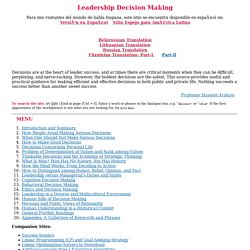
Thirty-five years ago an entrepreneurial leader, Robert Cowan, recognized a new opportunity and asked, "Why do business meetings have to be conducted in person? Why can't they connect through television images? " Immersion: The individual concentrates on the problem and becomes immersed in it. He or she will recall and collect information that seems relevant, dreaming up alternatives without refining or evaluating them. Incubation: The person keeps the assembled information in mind for: a while. Insight: The problem-conquering solution flashes into the person's mind at an unexpected time, such as on the verge of sleep, during a shower, or while running. Verification and Application: The individual sets out to prove that the creative solution has merit. As with other types of personal development, leadership development requires considerable self-discipline.
Innovate like a Kindergartner - Peter Merholz. By Peter Merholz | 12:55 PM February 1, 2011 One of my most popular posts for hbr.org is “Why Design Thinking Won’t Save You“.

It clearly struck a chord, as well over a year since it was posted, it still regularly gets picked up in the Twittersphere. A quandary I’ve had is how to reconcile my distaste for the phrase design thinking with my appreciation for the kinds of activities it represents. Recently, I realized something.
What Makes Steve "Steve" Entrepreneurial. User Experience Matters: What Entrepreneurs Can Learn From "Objectified": Tech News and Analysis « Braun's Rams influenced Apple's Ive.
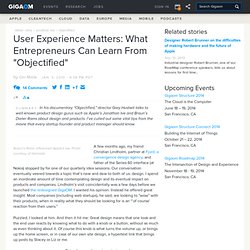
Entrepreneurship. The Genius of the Tinkerer. Supporting Entrepreneurs Everywhere. Full cost accounting. Environmental Full cost accounting (EFCA) generally refers to the process of collecting and presenting information — about environmental, social, and economic costs and benefits/advantages (collectively known as the "triple bottom line") - for each proposed alternative when a decision is necessary.
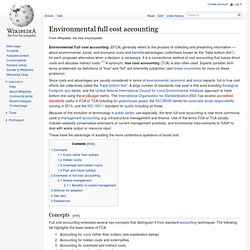
It is a conventional method of cost accounting that traces direct costs and allocates indirect costs. [1] A synonym, true cost accounting (TCA) is also often used. Experts consider both terms problematic as definitions of "true" and "full" are inherently subjective (see Green economics for more on these problems). Since costs and advantages are usually considered in terms of environmental, economic and social impacts, full or true cost efforts are collectively called the "triple bottom line". Because of this evolution of terminology in public sector use especially, the term full-cost accounting is now more commonly used in management accounting, e.g. infrastructure management and finance.
Triple bottom line. Graphic describing the three types of bottom lines Triple bottom line (abbreviated as TBL or 3BL) incorporates the notion of sustainability into business decisions. The TBL is an accounting framework with three dimensions: social, environmental (or ecological) and financial. The TBL dimensions are also commonly called the three Ps: people, planet and profits and are referred to as the "three pillars of sustainability. " Interest in triple bottom line accounting has been growing in both for-profit, nonprofit and government sectors. Many organizations have adopted the TBL framework to evaluate their performance in a broader context.[1] What Is The Immigrant Perspective? While immigrants have created new opportunities for America's corporations that have contributed greatly to the economy, there exists a tremendous gap in how to utilize the immigrant population in the US.
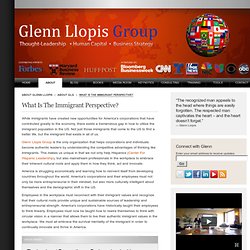
Not just those immigrants that come to the US to find a better life, but the immigrant that exists in all of us. Glenn Llopis Group is the only organization that helps corporations and individuals become authentic leaders by understanding the competitive advantages of thinking like immigrants. This makes us unique in that we not only help Hispanics (Center For Hispanic Leadership), but also mainstream professionals in the workplace to embrace their inherent cultural roots and apply them in how they think, act and innovate. America is struggling economically and learning how to reinvent itself from developing countries throughout the world.
The Immigrant Perspective on Business Leadership By Glenn Llopis, October 2011. 4 Skills that Give Women a Sustainable Advantage Over Men. Startup America Partnership. What We Can All Learn From Amazon about Seeing Business Opportunities Others Don't See. Why Trader Joe's Stands Out From All the Rest in the Grocery Business.
Managing The Psychological Bias Against Creativity. Managing your patents. Key Advantage of Open Source is Not Cost Savings. Computer Economics recently conducted a survey of visitors to its website regarding the perceived advantages in the use of open source software.
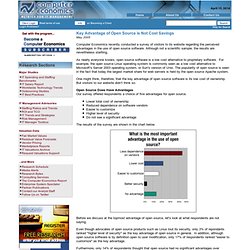
Although not a scientific sample, the results are nevertheless startling. As nearly everyone knows, open source software is a low cost alternative to proprietary software. For example, the open source Linux operating system is commonly seen as a low cost alternative to Microsoft's Server 2003 operating system, or Sun's version of Unix. The popularity of open source is seen in the fact that today the largest market share for web servers is held by the open source Apache system. One might think, therefore, that the key advantage of open source software is its low cost of ownership. Open Source Does Have AdvantagesOur survey offered respondents a choice of five advantages for open source. Lower total cost of ownershipReduced dependence on software vendors Easier to customizeHigher level of securityDo not see a significant advantage.
Benefits of Using Open Source Software. The outline flow of this section is as follows: Introduction Open Source's proponents often claim that it offers significant benefits when compared to typical commercial products.

Commercial products typically favour visible features (giving marketing advantage) over harder-to measure qualities such as stability, security and similar less glamorous attributes. Reverse innovation. Reverse innovation or trickle-up innovation is a term referring to an innovation seen first, or likely to be used first, in the developing world before spreading to the industrialized world.

The term was popularized by Dartmouth professors Vijay Govindarajan and Chris Trimble and GE's Jeffrey R. Immelt.[1][1][2][3][4] Subsequently, Vijay Govindarajan and Chris Trimble published the book Reverse Innovation.[5] Reverse innovation refers broadly to the process whereby goods developed as inexpensive models to meet the needs of developing nations, such as battery-operated medical instruments in countries with limited infrastructure, are then repackaged as low-cost innovative goods for Western buyers. Definition[edit] The process of reverse innovation begins by focusing on needs and requirements for low-cost products in countries like India and China. C.K. Reverse innovation in global health systems[edit] Other examples[edit] Raising Start-up Capital.